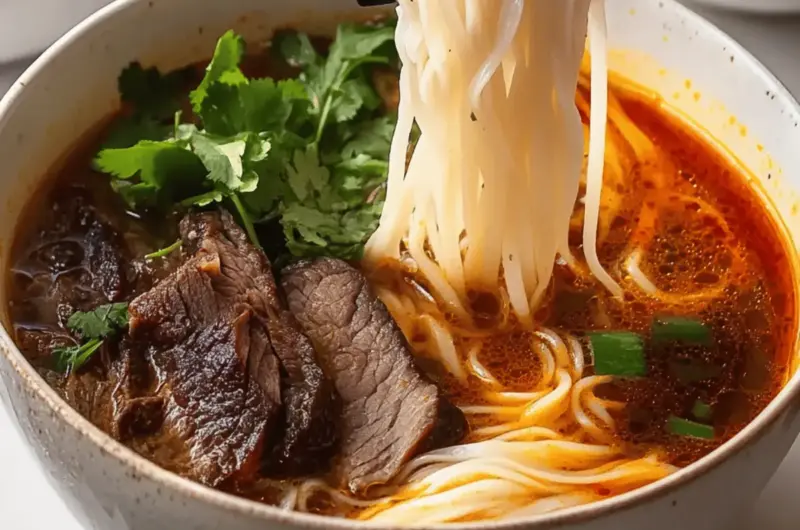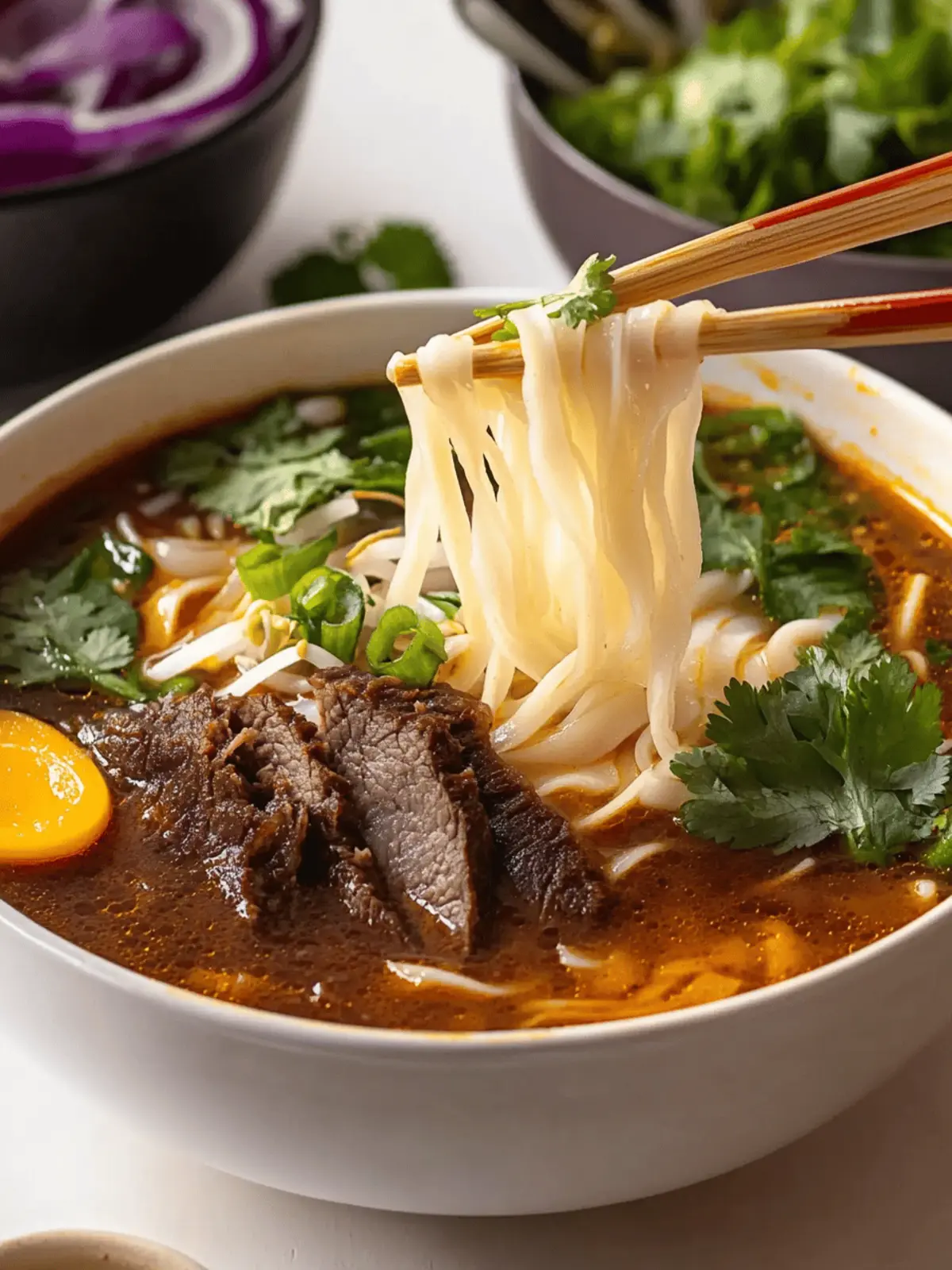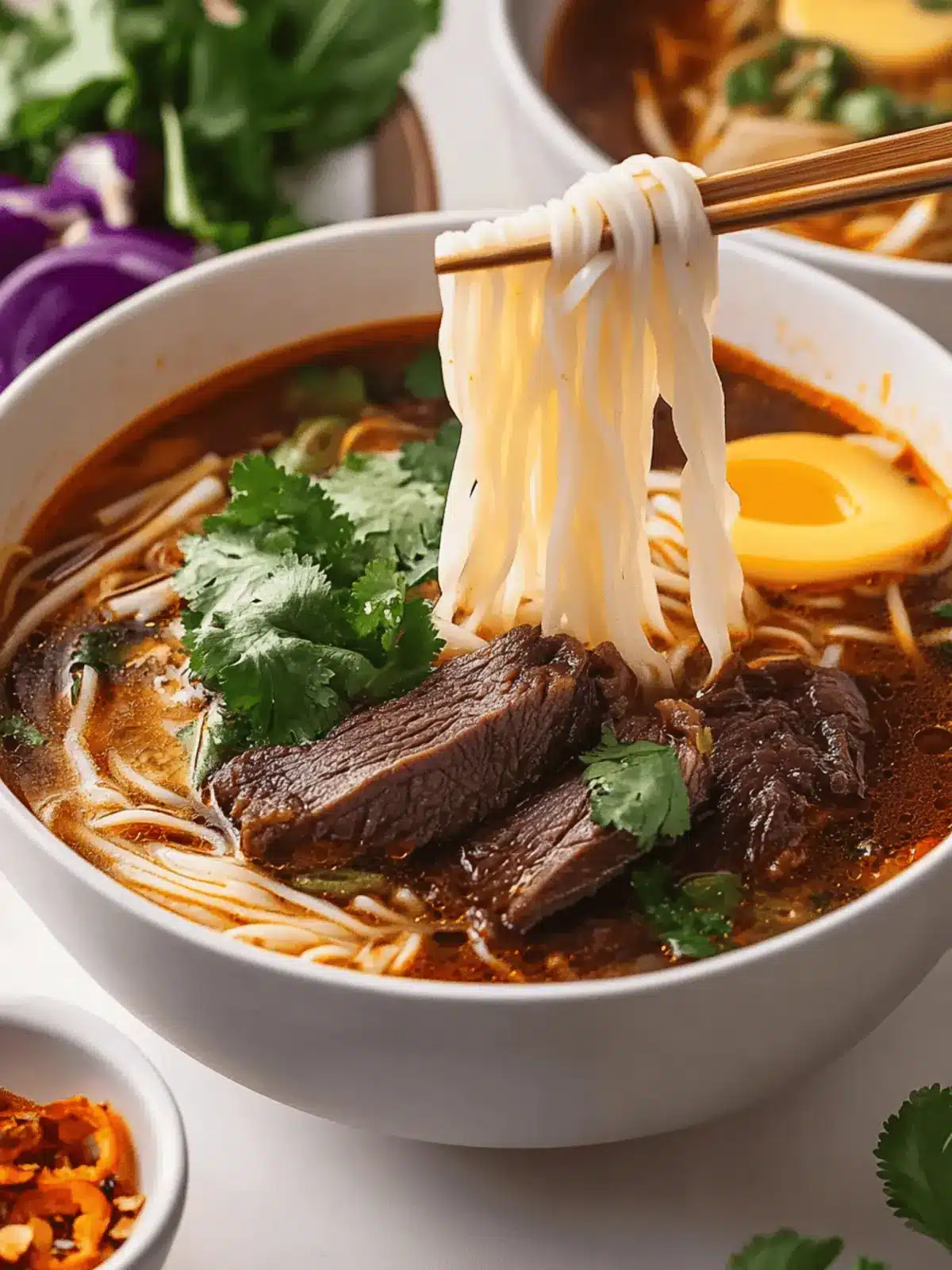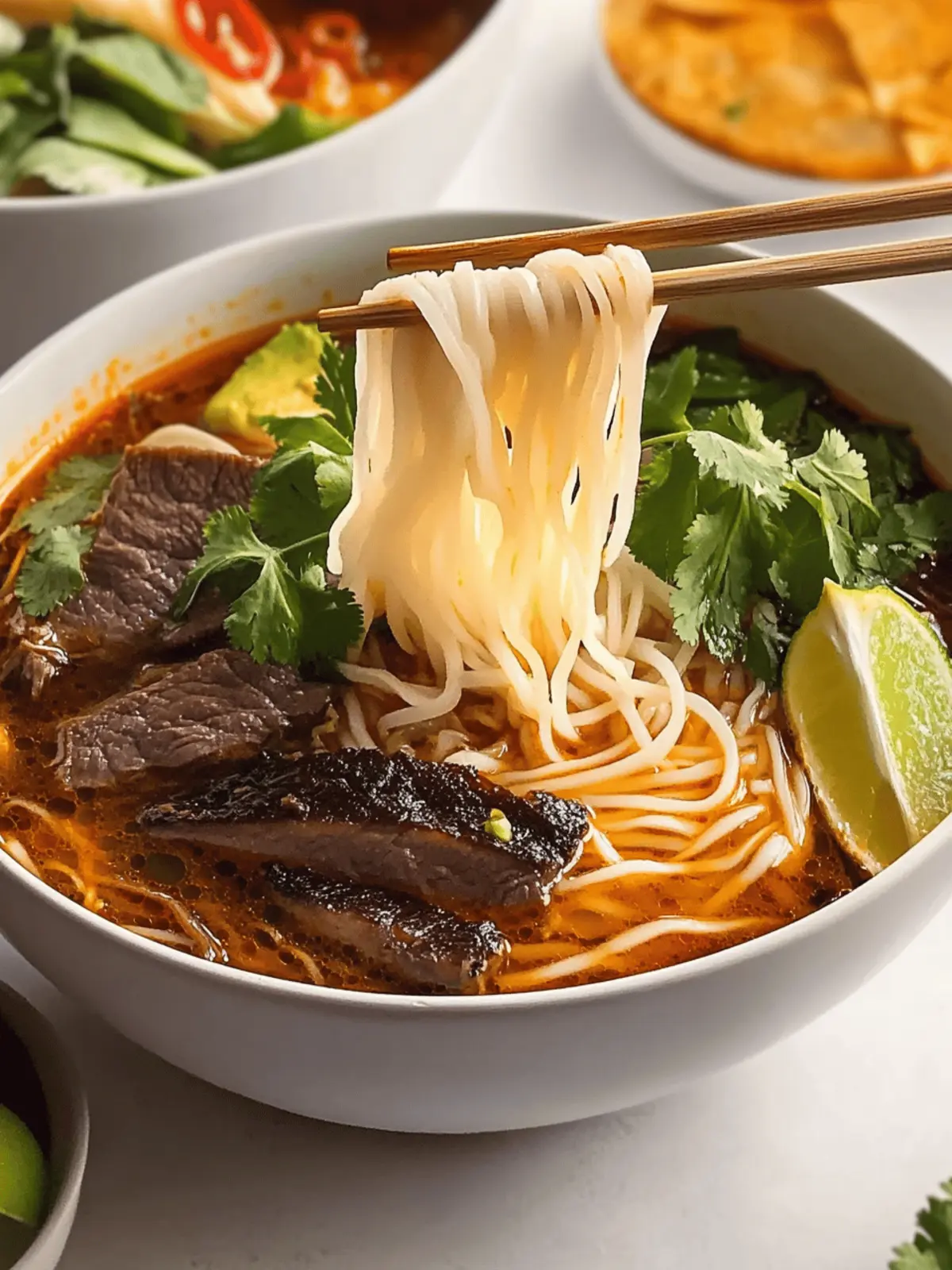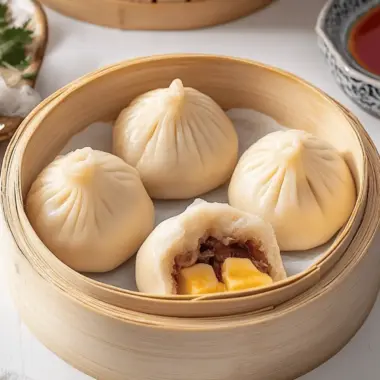The moment I first tasted Bun Bo Hue, I was transported to the bustling streets of Vietnam, where the air is thick with the aroma of spices and simmering broth. There’s an undeniable warmth that comes with a bowl of this spicy Vietnamese beef noodle soup—perfectly tender beef shank and succulent pork hocks nestled in a vibrant, fiery broth that tantalizes your taste buds. As I stirred in the fresh herbs and adjusted the heat, it felt like crafting a personal masterpiece, each bite customizable to suit my cravings.
Whether you’re seeking a hearty meal after a long day or a cozy dish to impress friends at your next gathering, this Bun Bo Hue recipe is your answer. Not only does it deliver on flavor, but it also invites you to explore your spice preferences. So grab your apron and let’s bring a touch of Vietnam to your kitchen!
Why is Spicy Vietnamese Beef Noodle Soup a Must-Try?
Comforting Warmth: This soup is a hug in a bowl, perfect for chilly evenings.
Customizable Spice: Tailor the heat to your liking, ensuring every bowl is uniquely yours.
Rich and Flavorful: Slow-cooked beef and herbs create complex, savory notes with each slurp.
Simple Ingredients: Using straightforward, accessible ingredients makes it an easy dish to prepare.
Crowd-Pleasing: Ideal for gatherings, it satisfies both foodies and casual diners alike.
Whether serving it for a family dinner or sharing with friends, this Spicy Vietnamese Beef Noodle Soup will surely impress!
Spicy Vietnamese Beef Noodle Soup Ingredients
For the Broth
- Pork Hocks – Provides rich flavor and texture to the broth; substitute with additional beef shank or chicken for a lighter broth.
- Beef Shank – The main protein source, offering tenderness and a hearty bite; chuck roast can also work but may alter the flavor.
- Chicken Broth (low sodium) – Base for the soup that enhances depth of flavor; consider homemade meat broth or water as a substitute.
- Water – Dilutes broth for the desired consistency; swapping equal parts low-sodium broth adds more flavor.
- Shrimp Paste – Adds umami and a unique flavor to the broth; fish sauce can be a great alternative.
- Palm Sugar – Balances spice and adds sweetness; you can use brown sugar or cane sugar in equal amounts.
- Yellow Onion – An aromatic base for the broth; shallots can be swapped in for a sweeter taste.
- Lemongrass – Imparts a fresh, citrusy flavor; be sure to use fresh stalks, as dried is less effective.
- Daikon – Provides sweetness and texture to the broth; white radish can be used instead.
- Salt – Essential for flavor adjustment; use sparingly and adjust to taste.
- Chicken Bouillon Powder – Enhances overall meatiness in the broth; vegetable bouillon can be used for a vegetarian option.
- Fish Sauce – Imparts a distinct savory flavor; adjust according to your taste preferences.
For the Sate Chili Sauce
- Vegetable Oil – For cooking the spices; ensure high-quality oil for the best flavor.
- Annatto Seeds – Adds color and subtle flavor to the oil; infuse oil before use.
- Dried Chili Flakes – Provides heat; adjust the quantity based on your spice tolerance.
- Garlic – Deepens the flavor profile; consider chopping fresh garlic for more pungency.
- Shallots – Adds sweetness and depth to the sauce; yellow onions can be a substitute.
For Serving
- Thick Rice Noodles – The base of the soup; opt for fresh vermicelli noodles for quicker prep.
- Vietnamese Pork Sausage (Cha Lua) – Topping for added flavor and texture; can be omitted for a lighter option.
- Fresh Herbs and Vegetables – Such as cilantro, green onion, banana blossom, bean sprouts, Vietnamese coriander, culantro, mint, purple cabbage, and lime; provide freshness against the spicy broth.
This collection of ingredients is essential to create a truly unforgettable Spicy Vietnamese Beef Noodle Soup that will warm your soul and delight your taste buds!
How to Make Spicy Vietnamese Beef Noodle Soup
-
Parboil: In separate pots, parboil the beef shank and pork hocks for about 5 minutes to clean the impurities. Once done, rinse them under cold water for a cleaner taste.
-
Cook Broth: In a large stockpot, combine the parboiled meats, chicken broth, water, halved onion, lemongrass, daikon, palm sugar, and salt. Bring to a boil, then reduce to a simmer for 90-100 minutes, until everything is tender.
-
Dissolve Shrimp Paste: Mix the shrimp paste with a little water, let it settle, and add the clear broth to the pot after the beef has cooked for 90 minutes. Discard any sediment that collects at the bottom.
-
Add Lemongrass and Seasonings: Add the remaining lemongrass, chicken bouillon, and any additional water needed. Let it simmer for another 2 hours, building those deep, complex flavors.
-
Finish Broth: Stir in a splash of fish sauce and taste your broth, adjusting seasoning as necessary. Once cooled, remove the meat and slice it for serving.
-
Make Sate Sauce: In a small pan, heat the vegetable oil with annatto seeds to infuse color and flavor. Strain out the seeds, then sauté the dried chili flakes, lemongrass, garlic, and shallots in the oil until aromatic.
-
Combine: Gradually add your homemade sate sauce to the broth, tasting as you go to find the perfect spice level for you.
-
Serve: Cook the thick rice noodles according to package instructions. Assemble bowls with a generous serving of noodles, topped with sliced meats, broth, and a sprinkle of fresh herbs for that aromatic finish.
Optional: Serve with lime wedges and a side of fresh herbs for an extra burst of flavor.
Exact quantities are listed in the recipe card below.
Make Ahead Options
Bun Bo Hue is perfect for meal prep enthusiasts looking to save time during busy weeknights! You can prepare the broth up to 3 days in advance and store it in airtight containers in the refrigerator. To maintain quality, let the broth cool completely before refrigerating, and reheat gently on the stove when you’re ready to serve. Additionally, the thick rice noodles can be cooked and stored separately for up to 24 hours in the fridge; just toss them with a bit of oil to prevent sticking. When you’re ready to enjoy your spicy Vietnamese beef noodle soup, simply reheat the broth, add in the noodles, slice the meats, and top with fresh herbs for restaurant-quality results with minimal effort!
How to Store and Freeze Spicy Vietnamese Beef Noodle Soup
Fridge: Store any leftover spicy Vietnamese beef noodle soup in an airtight container for up to 3 days. Make sure to cool it to room temperature before refrigerating.
Freezer: You can freeze the broth separately from the noodles and toppings for up to 3 months. Let the broth cool completely, then pour it into freezer bags, removing as much air as possible.
Reheating: When ready to enjoy, thaw the broth overnight in the refrigerator, then reheat it on the stovetop. Just before serving, cook fresh noodles and add your favorite toppings for the best texture and flavor.
Noodle Storage: If you’ve already combined the noodles with broth, be aware that they may become mushy if stored together. It’s best to keep them separate until you’re ready to serve.
What to Serve with Spicy Vietnamese Beef Noodle Soup?
Elevate your meal experience with some delightful accompaniments that complement the robust flavors of this comforting soup.
- Fresh Spring Rolls: Light and crunchy, these rolls filled with shrimp or vegetables balance the hearty broth beautifully.
- Jasmine Rice: Serve fluffy jasmine rice on the side to soak up the flavorful broth, adding a delightful texture contrast.
- Mango Salad: A refreshing mango salad with lime dressing offers sweetness and acidity, enhancing the complexity of the soup.
- Grilled Shrimp Skewers: Smoky, tender shrimp provide a protein-packed addition that pairs perfectly with the rich flavors.
- Pickled Vegetables: Tart and crunchy pickled veggies add a zesty kick, cleansing the palate between bites of the intense broth.
- Chili Oil: Drizzle some homemade chili oil on top for an extra layer of spice and flavor to make each bowl truly yours.
- Herb Platter: A mix of fresh herbs like cilantro, mint, and Thai basil brightens up the soup and adds refreshing elements to each spoonful.
- Coconut Sticky Rice: Sweet, chewy coconut sticky rice can serve as a dessert; it complements the spicy soup wonderfully!
- Iced Green Tea: A cool beverage like iced green tea offers a refreshing contrast to the heat of the soup while cleansing the palate.
Spicy Vietnamese Beef Noodle Soup Variations
Feel free to get creative with this recipe and add your personal touch to transform your dish into something uniquely yours!
- Vegetarian: Replace beef and pork with tofu or seitan, using vegetable broth for a satisfying meatless option.
- Heat Adjustment: Add more chili flakes or fresh Thai chilies for a fiery kick, or reduce them for a milder taste.
- Noodle Alternatives: Swap thick rice noodles for soba or udon noodles if you’re feeling adventurous or if they’re more accessible.
Transform your dish with these ideas! You could even mix and match for a delightful fusion of flavors.
- Herb Variations: Experiment with different herbs like basil or parsley to complement the broth. Freshness can be a game-changer!
- Coconut Milk: Stir in a splash of coconut milk for an added layer of creaminess and a slightly sweet touch.
- Extra Umami: Incorporate dried mushrooms or a spoonful of miso paste for an extra savory depth to the broth.
These ideas are perfect for adjusting to your pantry contents or flavor desires—on the journey to a comforting bowl of Spicy Vietnamese Beef Noodle Soup, every twist adds to the experience!
Tips for the Best Spicy Vietnamese Beef Noodle Soup
- Rinse After Parboiling: Thoroughly rinse the meats after parboiling to ensure a clean and clear broth, avoiding any impurities.
- Taste as You Go: Always taste the broth after adding ingredients, especially when adjusting spice levels with the sate sauce—this ensures you achieve your preferred flavor.
- Strain for Clarity: For an exceptionally clear broth, strain the finished soup through a fine mesh sieve to remove any sediment or bits.
- Slow Simmer Counts: Take your time with the simmering process; longer cooking enhances the flavors and tenderizes the meat for that melt-in-your-mouth experience in your Spicy Vietnamese Beef Noodle Soup.
- Customize Your Herbs: Feel free to adjust the herbs based on your preference or what’s in season—this will elevate your soup and make it uniquely yours!
Spicy Vietnamese Beef Noodle Soup Recipe FAQs
What is the best way to select ripe ingredients for this recipe?
Absolutely! When choosing your ingredients, look for fresh lemongrass with a firm texture and a vibrant green color. For the daikon, select firm ones without dark spots all over. Fresh herbs, like cilantro and mint, should be aromatic with no wilting. Always opt for quality meats with a bright red color for the beef shank and a nice golden hue for the pork hocks.
How can I store leftover Spicy Vietnamese Beef Noodle Soup?
Very! Store any leftover soup in an airtight container in the fridge for up to 3 days. Make sure it reaches room temperature before refrigerating. To keep the noodles from becoming mushy, I recommend storing them separately from the broth.
Can I freeze Spicy Vietnamese Beef Noodle Soup?
Yes, you can! Freeze the broth separately from the noodles and toppings for up to 3 months. To do this, let the broth cool completely, then pour it into freezer bags, ensuring as much air is removed as possible before sealing. When you’re ready to enjoy it, thaw the broth in the refrigerator overnight, then reheat on the stovetop and cook fresh noodles just before serving.
What should I do if my broth is too salty?
If your broth turns out too salty, don’t worry! You can add a raw potato to the simmering broth and let it cook for about 10-15 minutes; the potato absorbs some of the saltiness. Alternatively, you can balance out the flavors by adding more water or low-sodium broth to dilute it.
Is this recipe suitable for those with dietary restrictions or allergies?
Absolutely! To make this recipe more inclusive, you can easily swap out ingredients like shrimp paste with fish sauce for different flavor profiles, or even leave it out for vegetarian options. Make sure to check for any specific allergies, especially with fish sauce or pork ingredients, and feel free to use alternative proteins like chicken or tofu.
How can I adjust the spice level in my Spicy Vietnamese Beef Noodle Soup?
The more the merrier! To customize the heat of your soup, start with a smaller amount of dried chili flakes in the Sate Chili Sauce and taste as you go. You can always add more for an increased spiciness, but remember to taste the broth after each addition to achieve your desired heat level. Enjoy the journey of flavor!
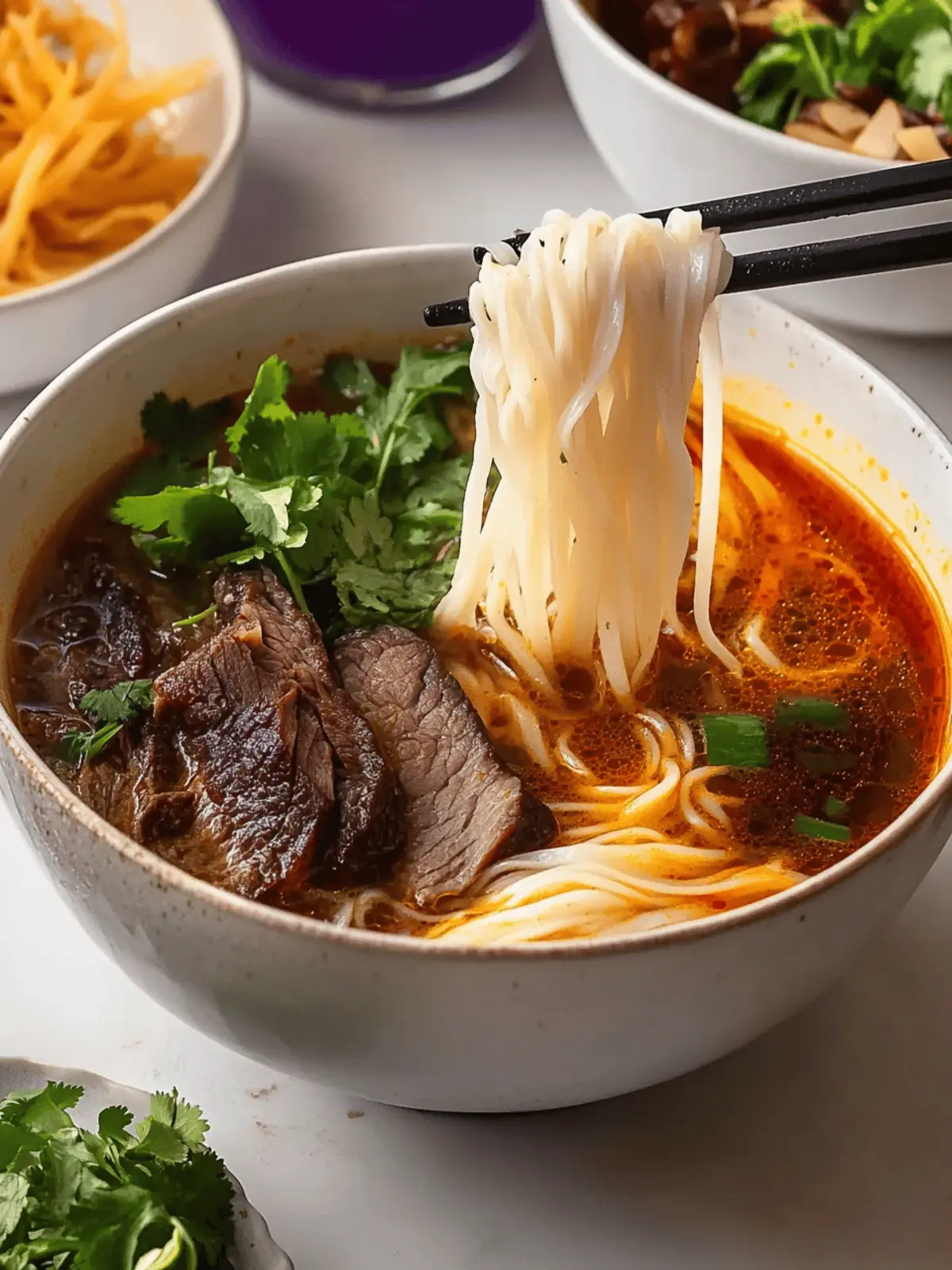
Ultimate Spicy Vietnamese Beef Noodle Soup for Cozy Nights
Ingredients
Equipment
Method
- Parboil: In separate pots, parboil the beef shank and pork hocks for about 5 minutes to clean the impurities. Rinse under cold water.
- Cook Broth: In a large stockpot, combine the parboiled meats, chicken broth, water, halved onion, lemongrass, daikon, palm sugar, and salt. Bring to a boil, then reduce to a simmer for 90-100 minutes.
- Dissolve Shrimp Paste: Mix the shrimp paste with a little water, let it settle, and add the clear broth to the pot after 90 minutes.
- Add Lemongrass and Seasonings: Add the remaining lemongrass, chicken bouillon, and any additional water needed. Simmer for another 2 hours.
- Finish Broth: Stir in fish sauce, taste your broth and adjust seasoning as necessary. Once cooled, slice the meats for serving.
- Make Sate Sauce: In a small pan, heat the vegetable oil with annatto seeds to infuse color and flavor. Strain out the seeds, then sauté the dried chili flakes, lemongrass, garlic, and shallots.
- Combine: Gradually add your homemade sate sauce to the broth, tasting as you go.
- Serve: Cook the thick rice noodles according to package instructions. Assemble bowls with noodles, sliced meats, broth, and fresh herbs.

